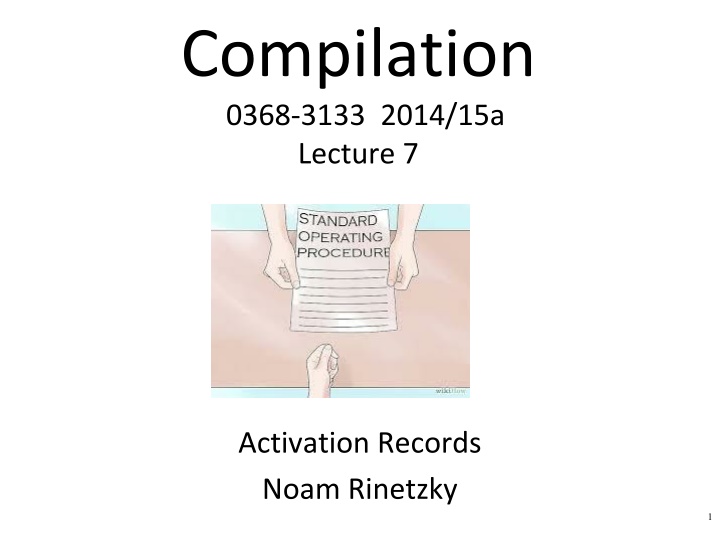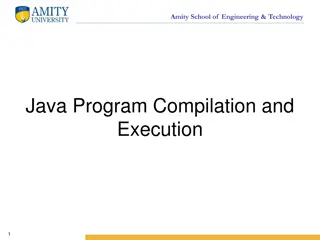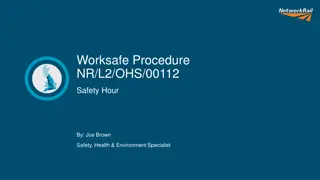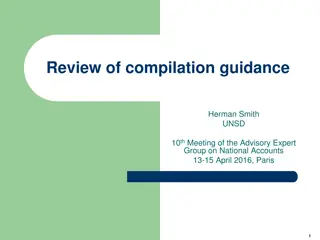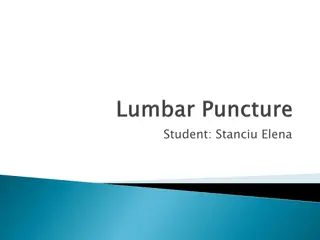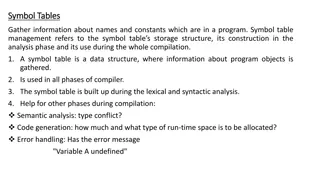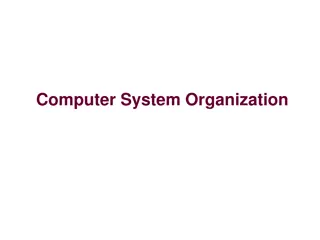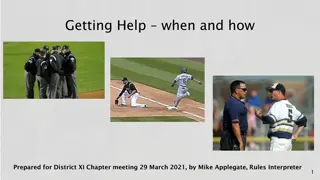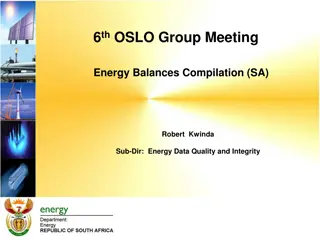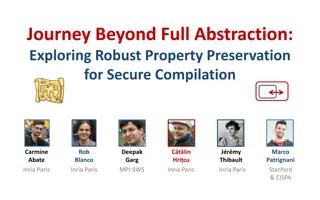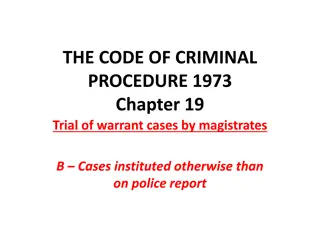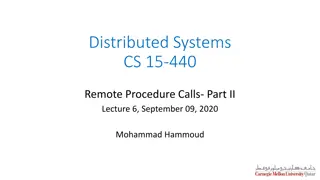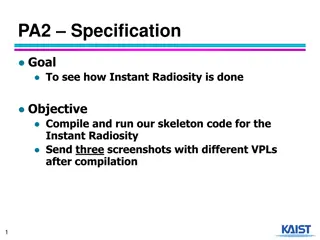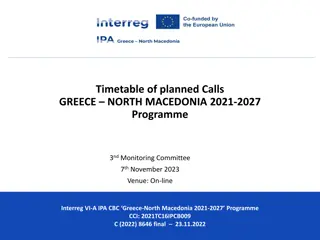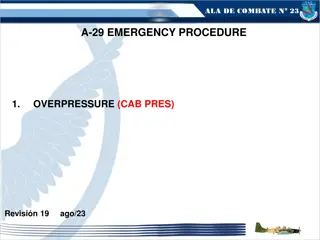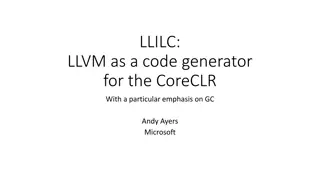Code Generation and Procedure Calls in Compilation
This compilation delves into the intricacies of code generation for procedure calls, exploring topics such as activation records, supporting procedures stack, calling conventions, and abstract register machines. It provides insights into the handling of procedures, including the management of local variables and temporaries within stack frames. The visual aids and explanations offered in this lecture series offer a comprehensive understanding of the mechanisms involved in compilation processes.
Download Presentation

Please find below an Image/Link to download the presentation.
The content on the website is provided AS IS for your information and personal use only. It may not be sold, licensed, or shared on other websites without obtaining consent from the author.If you encounter any issues during the download, it is possible that the publisher has removed the file from their server.
You are allowed to download the files provided on this website for personal or commercial use, subject to the condition that they are used lawfully. All files are the property of their respective owners.
The content on the website is provided AS IS for your information and personal use only. It may not be sold, licensed, or shared on other websites without obtaining consent from the author.
E N D
Presentation Transcript
Compilation 0368-3133 2014/15a Lecture 7 Activation Records Noam Rinetzky 1
Code generation for procedure calls (+ a few words on the runtime system) 2
Code generation for procedure calls Compile time generation of code for procedure invocations Activation Records (aka Stack Frames) 3
Supporting Procedures Stack: a new computing environment e.g., temporary memory for local variables Passing information into the new environment Parameters Transfer of control to/from procedure Handling return values 4
Calling Conventions In general, compiler can use any convention to handle procedures In practice, CPUs specify standards Aka calling conventios Allows for compiler interoperability Libraries! 5
Abstract Register Machine (High Level View) CPU Code General purpose Register 00 High (data) registers addresses Register 01 Register xx Data registers Register PC Control Low addresses 6
Abstract Register Machine (High Level View) CPU Main Memory Code General purpose Register 00 High (data) registers Global Variables addresses Register 01 Stack Register xx registers Register PC Control Register Stack Heap Low addresses 7
Abstract Activation Record Stack Stack grows this way main Prock Proc1 Proc2 Prock Stack frame for procedure Prock+1(a1, ,aN) Prock+1 Prock+1 Prock+2 Prock+2 8
Abstract Stack Frame Prock Param N Param N-1 Parameters (actual arguments) Param 1 _t0 Stack frame for procedure Prock+1(a1, ,aN) _tk x Locals and temporaries y Prock+2 9
Handling Procedures Store local variables/temporaries in a stack A function call instruction pushes arguments to stack and jumps to the function label A statement x=f(a1, ,an); looks like Push a1; Push an; Call f; Pop x; // copy returned value Returning a value is done by pushing it to the stack (return x;) Push x; Return control to caller (and roll up stack) Return; 10
Abstract Register Machine CPU Main Memory Code General purpose Register 00 High (data) registers Global Variables addresses Register 01 Stack Register xx registers Register PC Control Heap Low addresses 11
Abstract Register Machine CPU Main Memory Code General purpose Register 00 High (data) registers Global Variables addresses Register 01 Stack Register xx registers Register PC Control Register Stack Heap Low addresses 12
Intro: Functions Example int SimpleFn(int z) { int x, y; x = x * y * z; return x; } _SimpleFn: _t0 = x * y; _t1 = _t0 * z; x = _t1; Push x; Return; main: _t0 = 137; Push _t0; Call _SimpleFn; Pop w; void main() { int w; w = SimpleFunction(137); } 13
What Can We Do with Procedures? Declarations & Definitions Call & Return Jumping out of procedures Passing & Returning procedures as parameters 14
Design Decisions Scoping rules Static scoping vs. dynamic scoping Caller/callee conventions Parameters Who saves register values? Allocating space for local variables 15
Static (lexical) Scoping main ( ) { int a = 0 ; int b = 0 ; { } printf ( %d %d\n , a, b) ; } a name refers to its (closest) enclosing scope int b = 1 ; { int a = 2 ; printf ( %d %d\n , a, b) } { int b = 3 ; printf ( %d %d\n , a, b) ; } printf ( %d %d\n , a, b) ; known at compile time B2 B0 B1 Declaration Scopes a=0 B0,B1,B3 B3 B3 b=0 B0 b=1 B1,B2 a=2 B2 b=3 B3 16
Dynamic Scoping Each identifier is associated with a global stack of bindings When entering scope where identifier is declared push declaration on identifier stack When exiting scope where identifier is declared pop identifier stack Evaluating the identifier in any context binds to the current top of stack Determined at runtime 17
Example int x = 42; int f() { return x; } int g() { int x = 1; return f(); } int main() { return g(); } What value is returned from main? Static scoping? Dynamic scoping? 18
Why do we care? We need to generate code to access variables Static scoping Identifier binding is known at compile time Address of the variable is known at compile time Assigning addresses to variables is part of code generation No runtime errors of access to undefined variable Can check types of variables 19
Variable addresses for static scoping: first attempt identifier address int x = 42; x (global) 0x42 x (inside g) 0x73 int f() { return x; } int g() { int x = 1; return f(); } int main() { return g(); } 20
Variable addresses for static scoping: first attempt int a [11] ; void quicksort(int m, int n) { int i; if (n > m) { i = partition(m, n); quicksort (m, i-1) ; quicksort (i+1, n) ; } what is the address of the variable i in the procedure quicksort? main() { ... quicksort (1, 9) ; } 21
Compile-Time Information on Variables Name Type Scope when is it recognized Duration Until when does its value exist Size How many bytes are required at runtime Address Fixed Relative Dynamic 22
Activation Record (Stack Frames) separate space for each procedure invocation managed at runtime code for managing it generated by the compiler desired properties efficient allocation and deallocation procedures are called frequently variable size different procedures may require different memory sizes 23
Semi-Abstract Register Machine CPU Main Memory High addresses General purpose Register 00 (data) registers Register 01 Register xx Global Variables registers Register PC Control Stack registers ebp Stack esp Heap Low addresses 24
Runtime Stack Stack of activation records Call = push new activation record Return = pop activation record Only one active activation record top of stack How do we handle recursion? 26
Activation Record (frame) high parameter k addresses incoming parameters parameter 1 return information stack grows down lexical pointer administrative part dynamic link registers & misc frame (base) pointer local variables temporaries stack pointer low next frame would be here addresses 27
Runtime Stack SP stack pointer top of current frame FP frame pointer base of current frame Sometimes called BP (base pointer) Usually points to a fixed offset from the start of the frame Previous frame stack grows down FP Current frame SP 28
Code Blocks Programming language provide code blocks void foo() { int x = 8 ; y=9;//1 { int x = y * y ;//2 } { int x = y * 7 ;//3} x = y + 1; } adminstrative x1 y1 x2 x3 29
L-Values of Local Variables The offset in the stack is known at compile time L-val(x) = FP+offset(x) x = 5 Load_Constant 5, R3 Store R3, offset(x)(FP) 30
Pentium Runtime Stack Register Usage Instruction Usage ESP Stack pointer push, pusha, push on runtime stack EBP Base pointer pop,popa, Base pointer call transfer control to called routine Pentium stack registers return transfer control back to caller Pentium stack and call/ret instructions 31
Accessing Stack Variables Use offset from FP (%ebp) Remember: stack grows downwards Above FP = parameters Below FP = locals Examples %ebp + 4 = return address %ebp + 8 = first parameter %ebp 4 = first local Param n param1 FP+8 Return address Previous fp FP FP-4 Local 1 Local n Param n param1 Return address SP 32
Factorial fact(int n) fact: pushl %ebp # save ebp movl %esp,%ebp # ebp=esp pushl %ebx # save ebx movl 8(%ebp),%ebx # ebx = n cmpl $1,%ebx # n = 1 ? jle .lresult # then done leal -1(%ebx),%eax # eax = n-1 pushl %eax # call fact # fact(n-1) imull %ebx,%eax # eax=retv*n jmp .lreturn # .lresult: movl $1,%eax # retv .lreturn: movl -4(%ebp),%ebx # restore ebx movl %ebp,%esp # restore esp popl %ebp # restore ebp EBP+8 n Return address Previous fp EBP old %ebp EBP-4 old %ebx old %eax Return address ESP (stack in intermediate point) 33 (disclaimer: real compiler can do better than that)
Call Sequences The processordoes not save the content of registers on procedure calls So who will? Caller saves and restores registers Callee saves and restores registers But can also have both save/restore some registers 34
Call Sequences Push caller-save registers Push actual parameters (in reverse order) caller Caller push code push return address (+ other admin info) Jump to call address call Push current base-pointer bp = sp Push local variables Push callee-save registers Callee push code callee (prologue) Callee pop code Pop callee-save registers Pop callee activation record Pop old base-pointer (epilogue) return pop return address Jump to address Caller pop code caller Pop return value + parameters Pop caller-save registers 35
To Callee-save or to Caller-save? Callee-saved registers need only be saved when callee modifies their value Some heuristics and conventions are followed 36
Caller-Save and Callee-Save Registers Callee-Save Registers Saved by the callee before modification Values are automatically preserved across calls Caller-Save Registers Saved (if needed) by the caller before calls Values are not automatically preserved across calls Usually the architecture defines caller-save and callee- save registers Separate compilation Interoperability between code produced by different compilers/languages But compiler writers decide when to use caller/callee registers 37
Callee-Save Registers Saved by the callee before modification Usually at procedure prolog Restored at procedure epilog Hardware support may be available Values are automatically preserved across calls .global _foo int foo(int a) { int b=a+1; f1(); g1(b); return(b+2); } Add_Constant -K, SP //allocate space for foo Store_Local R5, -14(FP) // save R5 Load_Reg R5, R0; Add_Constant R5, 1 JSR f1 ; JSR g1; Add_Constant R5, 2; Load_Reg R5, R0 Load_Local -14(FP), R5 // restore R5 Add_Constant K, SP; RTS // deallocate 38
Caller-Save Registers Saved by the caller before calls when needed Values are not automatically preserved across calls .global _bar Add_Constant -K, SP //allocate space for bar void bar (int y) { int x=y+1; f2(x); g2(2); g2(8); } Add_Constant R0, 1 JSR f2 Load_Constant 2, R0 ; JSR g2; Load_Constant 8, R0 ; JSR g2 Add_Constant K, SP // deallocate space for bar RTS 39
Parameter Passing 1960s In memory No recursion is allowed 1970s In stack 1980s In registers First k parameters are passed in registers (k=4 or k=6) Where is time saved? Most procedures are leaf procedures Interprocedural register allocation Many of the registers may be dead before another invocation Register windows are allocated in some architectures per call (e.g., sun Sparc) 40
Activation Records & Language Design 41
Compile-Time Information on Variables Name, type, size Address kind Fixed (global) Relative (local) Dynamic (frame unknown size) Scope when is it recognized Duration Until when does its value exist 42
Scoping int x = 42; int f() { return x; } int g() { int x = 1; return f(); } int main() { return g(); } What value is returned from main? Static scoping? Dynamic scoping? 43
Nested Procedures For example Pascal Any routine can have sub-routines Any sub-routine can access anything that is defined in its containing scope or inside the sub-routine itself non-local variables 44
Example: Nested Procedures program p(){ int x; procedure a(){ int y; procedure b(){ c() }; procedure c(){ int z; procedure d(){ y := x + z }; b() d() } a() c() } a() } Possible call sequence: p a a c b c d what are the addresses of variables x, y and z in procedure d? 45
Nested Procedures can call a sibling, ancestor when c uses (non-local) variables from a , which instance of a is it? Possible call sequence: p a a c b c d P how do you find the right activation record at runtime? a a b c c d 46
Nested Procedures goal: find the closest routine in the stack from a given nesting level if we reached the same routine in a sequence of calls routine of level k uses variables of the same nesting level, it uses its own variables if it uses variables of nesting level j < k then it must be the last routine called at level j If a procedure is last at level j on the stack, then it must be ancestor of the current routine Possible call sequence: p a a c b c d P a a b c c d 47
Nested Procedures problem: a routine may need to access variables of another routine that contains it statically solution: lexical pointer (a.k.a. access link) in the activation record lexical pointer points to the last activation record of the nesting level above it in our example, lexical pointer of d points to activation records of c lexical pointers created at runtime number of links to be traversed is known at compile time 48
Lexical Pointers program p(){ int x; procedure a(){ int y; procedure b(){c()}; procedure c(){ int z; procedure d(){ y := x + z }; b() d() } a() c() } a() } Possible call sequence: p a a c b c d a y a y P z c a a b b c c z c d d 49
Lexical Pointers program p(){ int x; procedure a(){ int y; procedure b(){c()}; procedure c(){ int z; procedure d(){ y := x + z }; b() d() } a() c() } a() } Possible call sequence: p a a c b c d a y a y P z c a a b b c c z c d d invokes nested in 50
